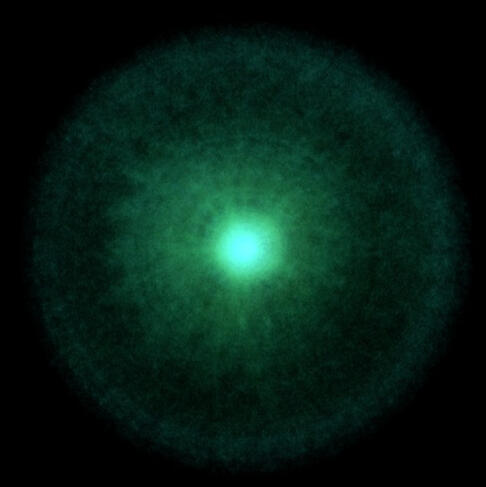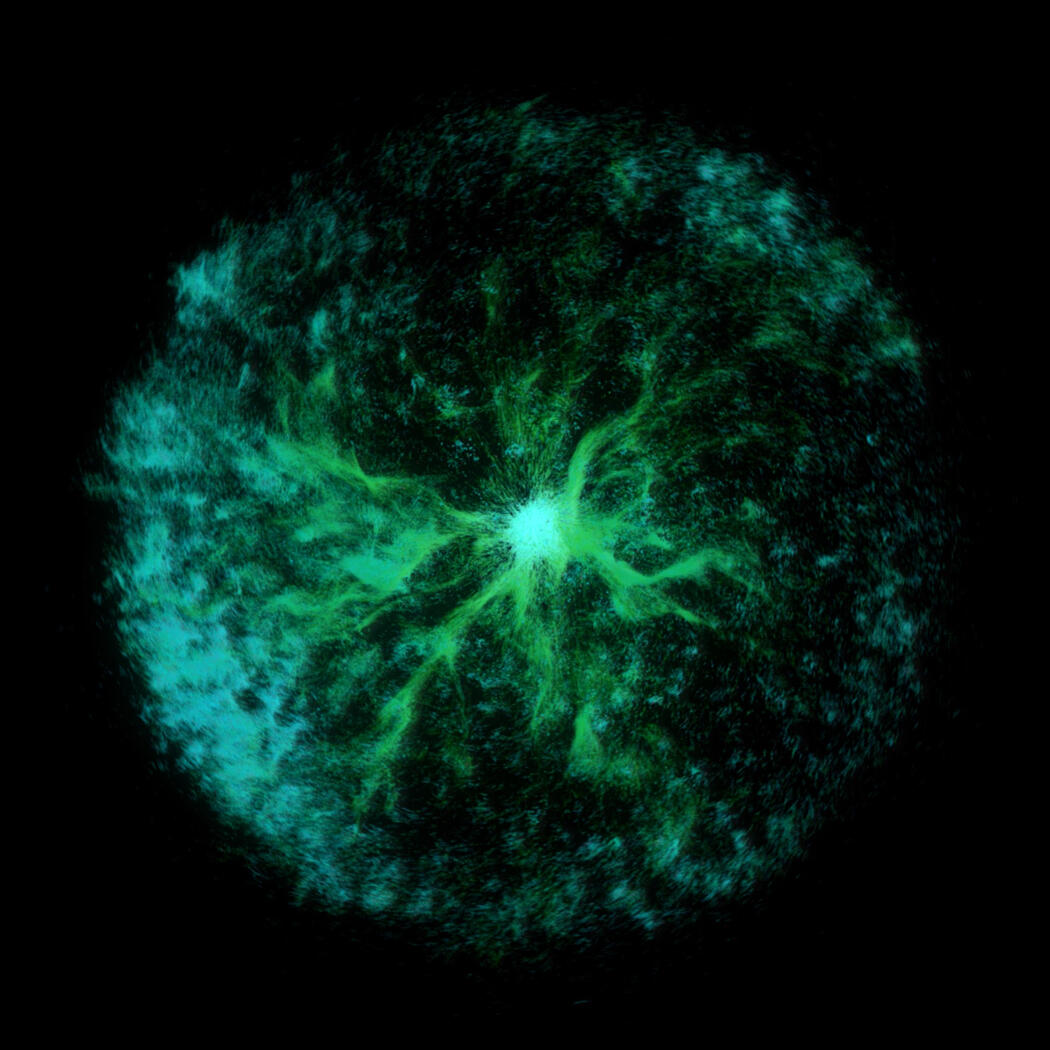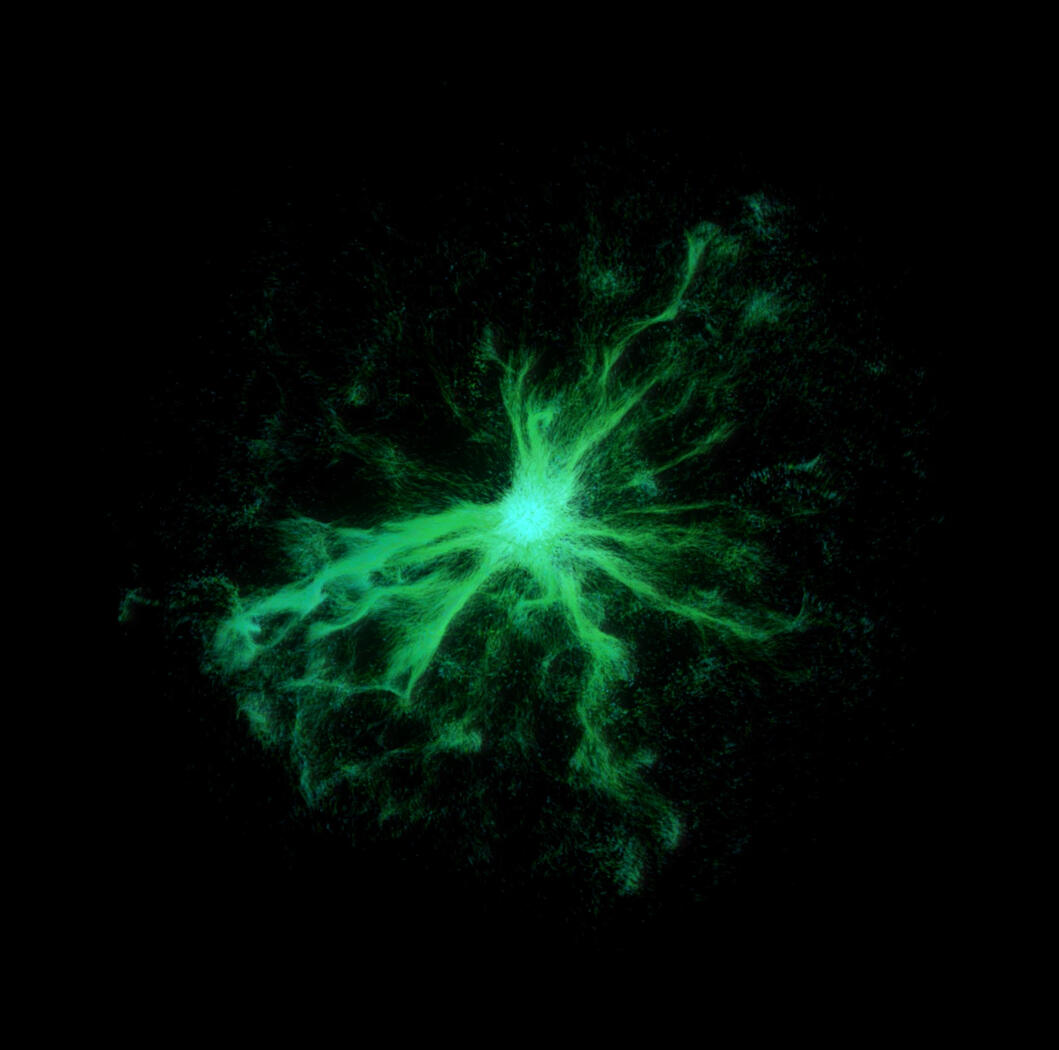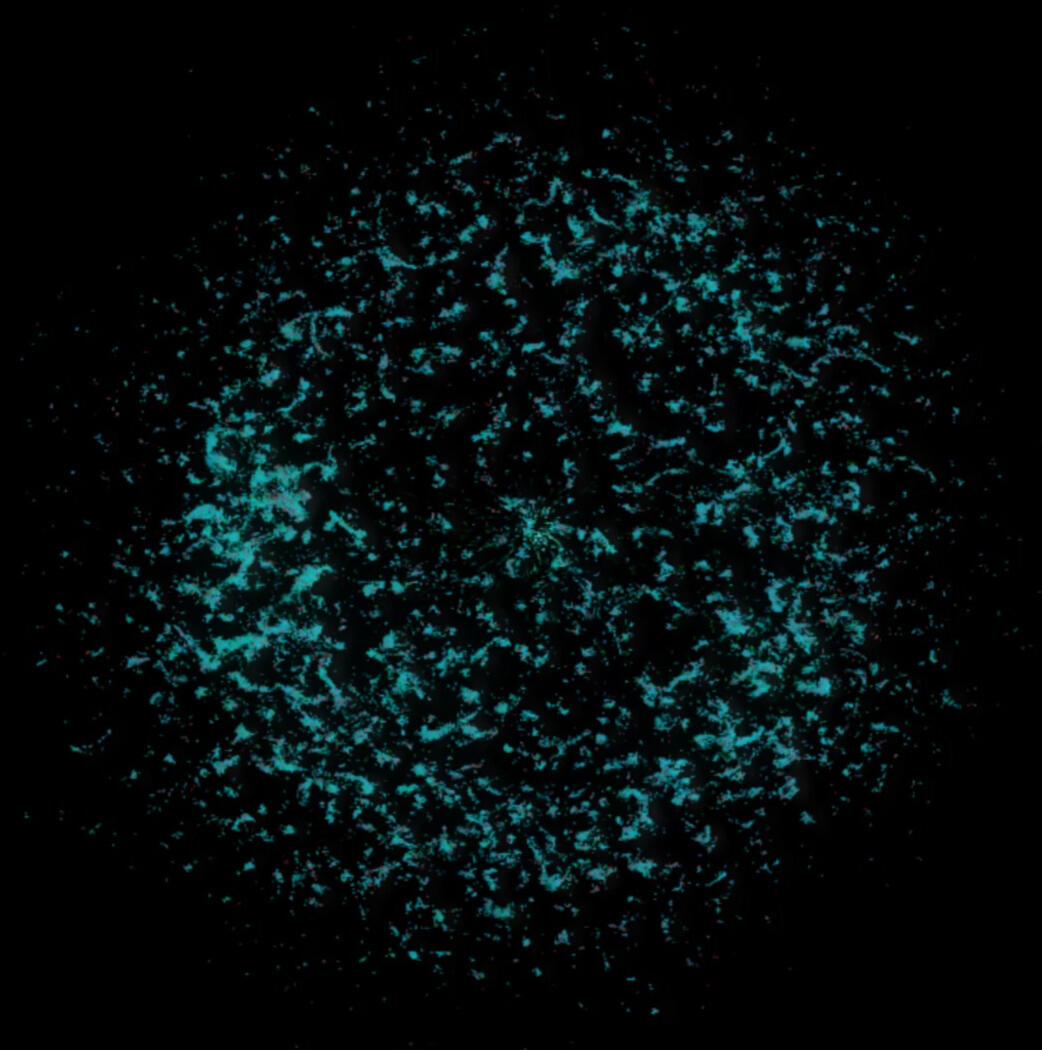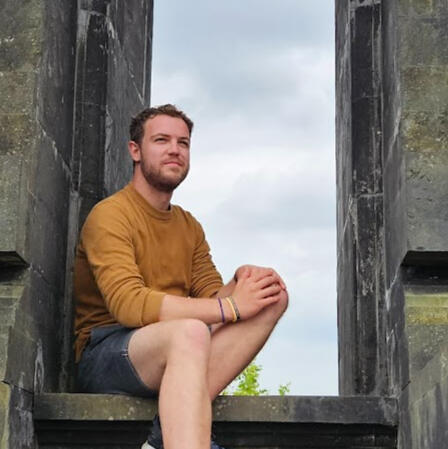
Hi, I'm Dries
I creatively innovate ideas focusing on interaction and game design, storytelling and generative coding.
Graduation project | Interaction & Audio Design
LOTKÍSÈM
A design inspired by language to promote a cultural connection between humans and natural environment.
Generative Art | Data | Audiodesign
Nature's Flow
A collection of various generative audio and visuals inspired by nature.
Game Design | Speculative design
Natura Humana
The time of nature is over in order for this A.I.-powered futuristic city to grow and thrive.
Story Design | Map design | Worldbuilding
Selatlugam
.
Speculative Design | Futuristic Cities
The New Canterbury Tales: Grand Hearing
Immersive storytelling through an interactive role-playing game for designers, engineers, stake-holders and citizens of the city of the future.
Webdesign | Storytelling
Interactive Story Map
As part of an online escape room, I created an interactive map for Project M.
Lotkísèm: Cultural Nature-connectedness
How can a design inspired by language promote a cultural connection between humans and the natural environment?
᚛ᚃᚒᚇᚌᚑᚎᚓᚅ (Lot•kí•sèm) translates to the concept of cultural natureconnectedness. This project aims to bridge the gap between humans and trees in the natural environment through language using an ambiguous approach¹. To achieve this, the Language for Trees called Tamperséwan was meticulously constructed based on an Irish writing system called Ogham. Using data inspired by tree rings, it sparked the creation of a narrative that is both readable and audible through an interactive installation telling the life's story of a tree.
'As growth rings lie silent in the tree until liberated by the axe, they sing out in the uprooted time.'²
Introduction
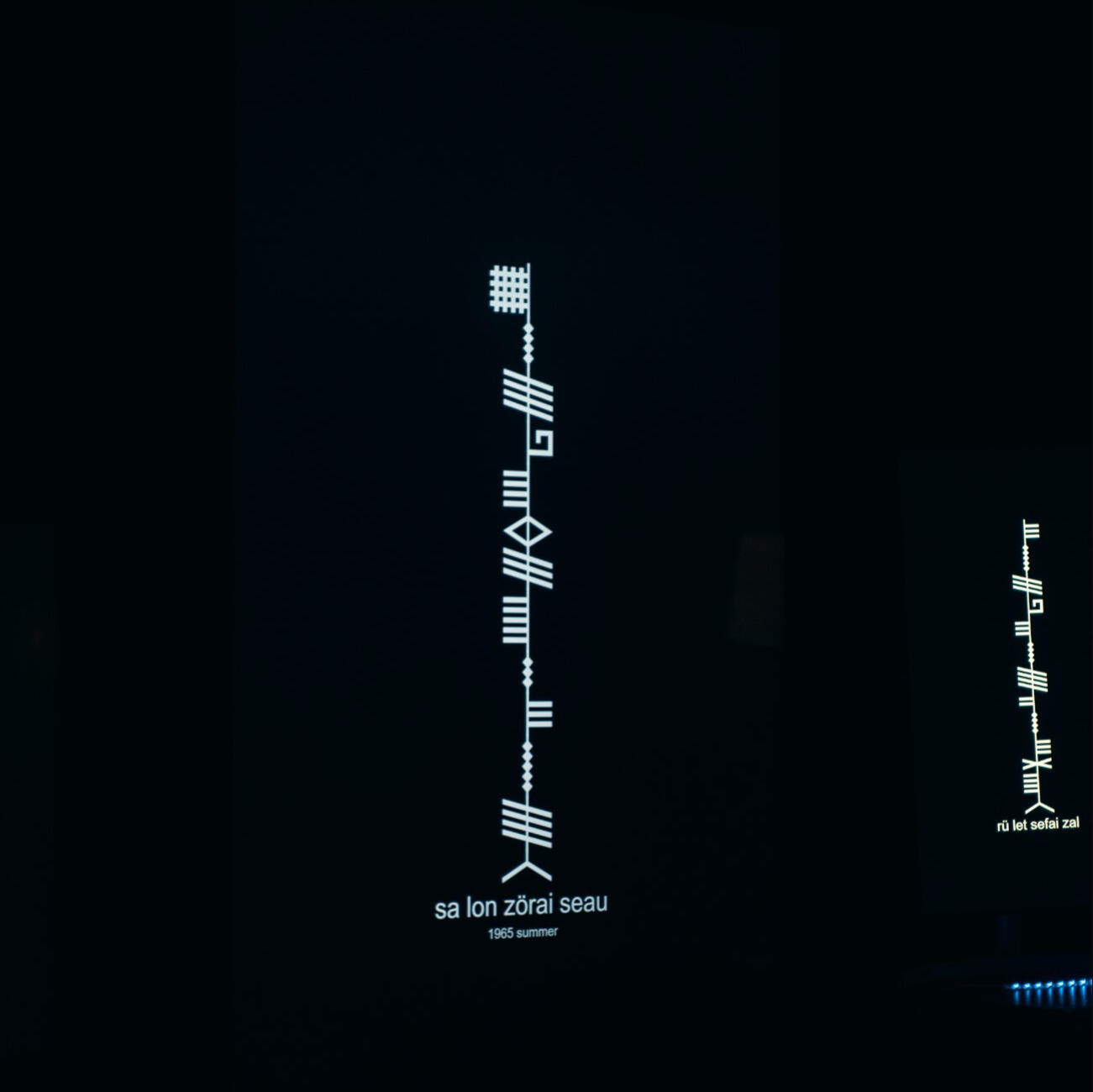
Lotkísèm, derived from a constructed language called Sèlatlúgam, translates to ‘to connect oneself with nature,’ or 'cultural natureconnectedness' embodying the inclusion of nature within cultural identity³ ⁴. It is written using the Ogham alphabet⁵ but with unique pronunciation and transliteration.Spoken and written by the people of Sèlatlúgam, Lotkísèm has a writing system called ‘Tamperséwan,’ the ‘language of trees.’ This language and culture was initially created during an earlier world building project in 2020.
Tamperséwan addresses the need for a language for the natural environment in the Anthropocene era. While our dictionaries abound with words for human emotions, they lack vocabulary to articulate the feelings or stories of nature.In this fictional world, Tamperséwan emerges from a culture deeply connected to nature. Words in this language are tailored to specific trees in specific conditions, reflecting the belief that trees encapsulate stories within their rings.In essence, Tamperséwan transforms historical data⁶ ⁷ derived from weather and its rings into a cultural nexus, offering words and sounds that unveil the hidden narrative within a tree’s rings.
Scope
The aim of this project is to confront the challenges posed by the Anthropocene era by constructing a language rooted in data, narrating the story from the perspective of a tree. Through words, symbols, and audio generated by an algorithm, we endeavor to deepen our understanding of trees and human influences on their vast lifespan. While direct communication with trees may seem difficult or even impossible, this project prompts us to ponder a thought-provoking question: 'What if there existed a culture capable of deciphering the life story of a tree?'.
The target audience encompasses individuals seeking a cultural bond with nature, fostering a poetic appreciation for the natural environment. While our comprehension of the natural world may be limited, this language serves as a conduit, sparking curiosity and nurturing a desire to delve deeper into nature's mysteries.Drawing inspiration from the works and research of Tolkien, the poetic psychology of 'The Dictionary of Obscure Sorrows', the book 'Tree: a life story', and the minimalist language Toki Pona, the approach was imbued with a sense of poetry. Like Tolkien, who crafted intricate worlds and cultures to enrich his languages, the aim is to connect individuals with their history, nature, and beliefs through storytelling.
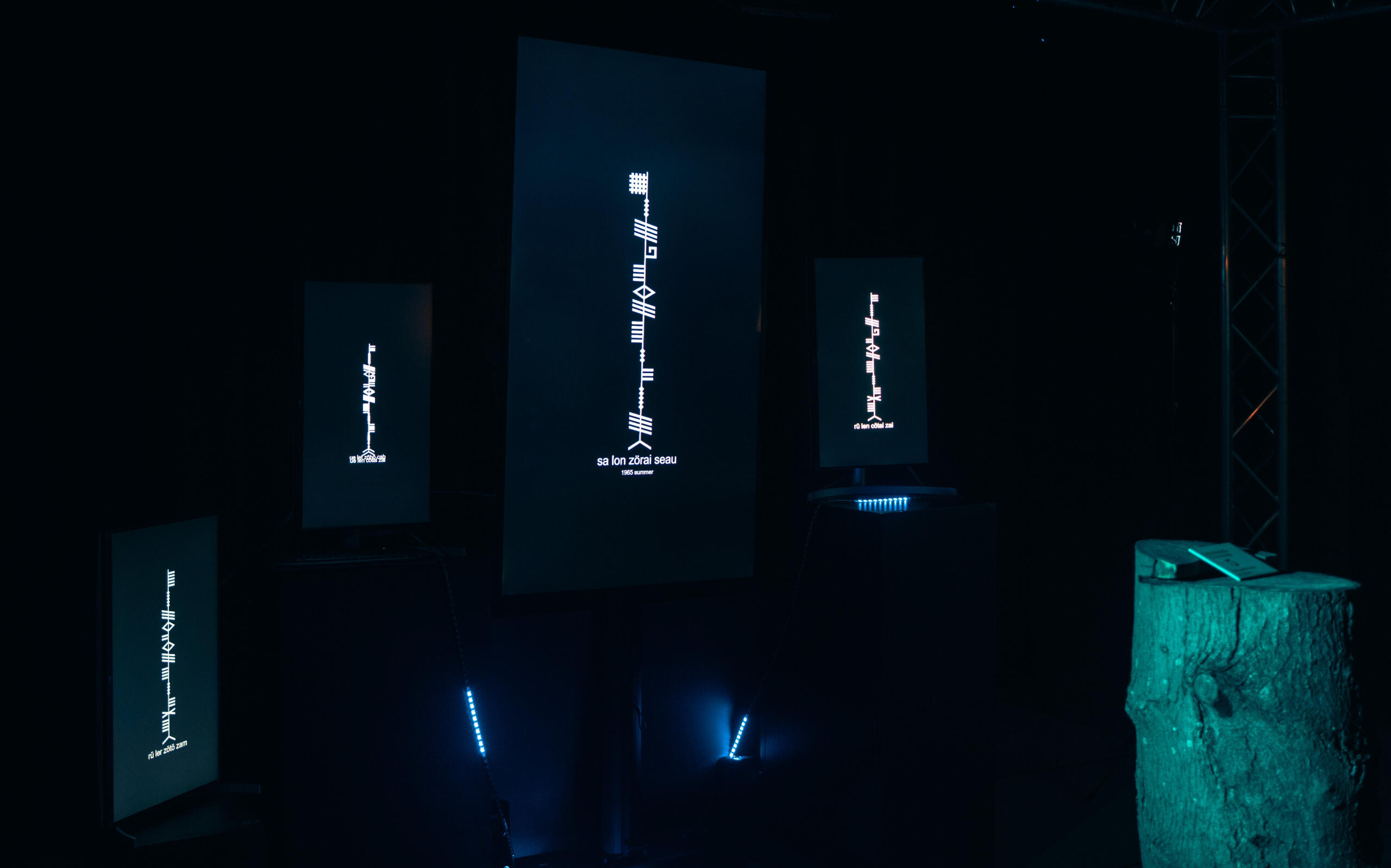
Lotkísèm Exhibition
Lotkísèm, the installation in its totality, is conceived as a museum exhibit dedicated to showcasing this constructed language as if it were a relic of folklore. The exhibition is designed to immerse visitors in the world of Lotkísèm, with one side featuring displays where the language's structure and nuances can be studied and learned. Across the room, multiple screens dynamically present the language, weaving narratives of various trees within an abstract forest setting.Lotkísèm, in its essence, is enigmatic or ambiguous¹. Comprising numerous layers of storytelling and linguistic metaphysics, the installation invites users to enter a realm of curiosity and awe. This sense of wonder ignites an interest in understanding the workings of this language system, prompting users to decide whether to delve into the cultural narrative of a tree’s life or simply interact with it and observe how the words evolve over time. Ultimately, the experience culminates in users becoming more engaged and immersed, deepening the sense of wonder with which they initially entered the installation.The main story the installation tells is one about a deceased tree that stood firm in the Mastbos in Breda for almost three centuries. Data gathered from various institutes such as KNMI and Climate Data were used to create story in the words told by this old beech tree.
Interaction
At the heart of the exhibit stands the main screen, where the focal point of this beech tree its story. The screens next to it resemble the other trees that once lived in the area or are still alive, surpassing the deceased tree its lifetime.Positioned in the center is a tree log serving as the primary interaction point for visitors. Through a "scrolling" mechanism, users can physically turn the log clockwise or counterclockwise to navigate through time to reveal the story of this tree, offering an engaging and tactile experience that brings the narrative to life.Furthermore, the interaction with the log serves as a symbolic representation of the interconnectedness between trees. As the log is turned, LEDs on an LED strip move between screens, symbolizing the flow of energy and communication among the trees in a blue color to create a tranquile environment.
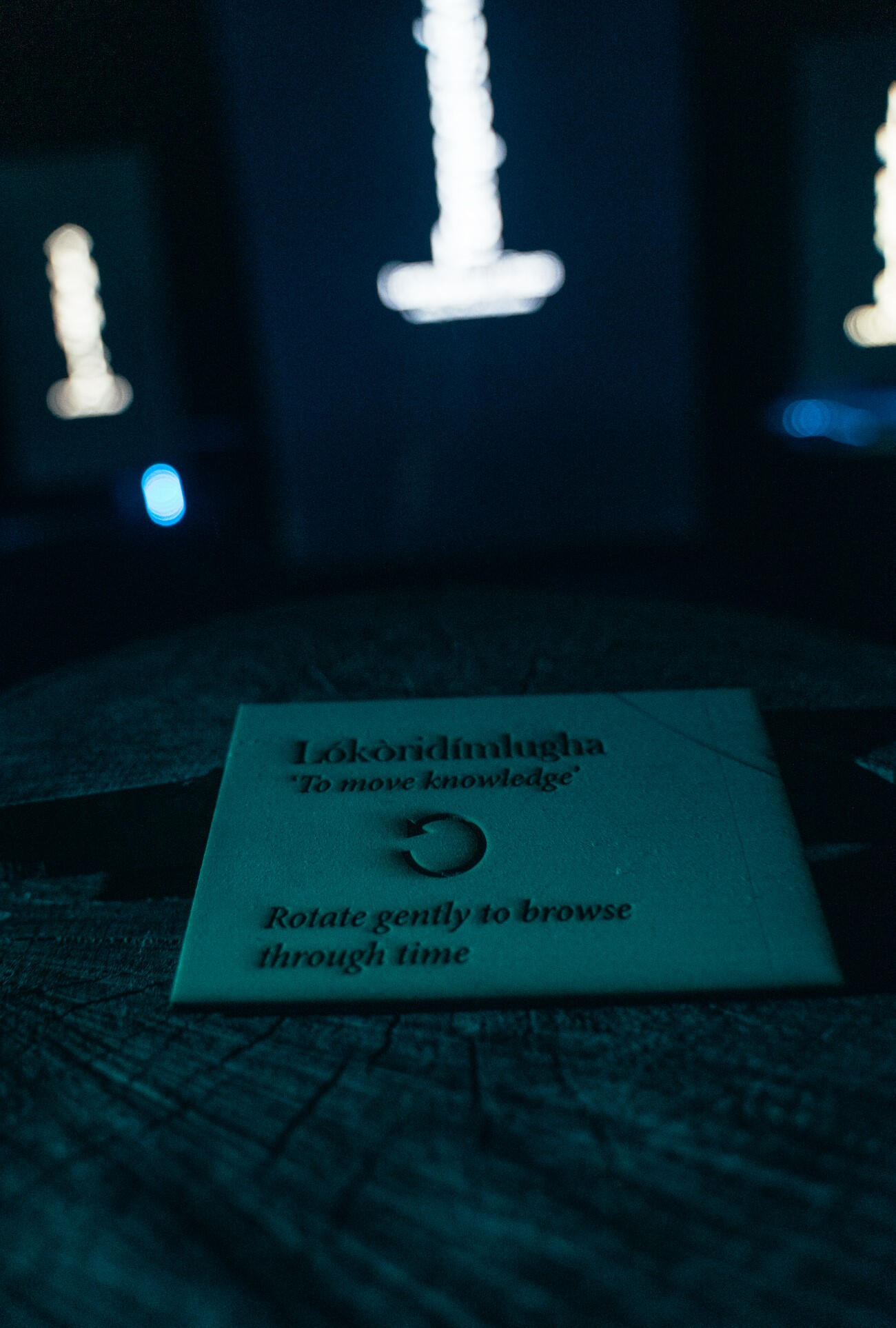
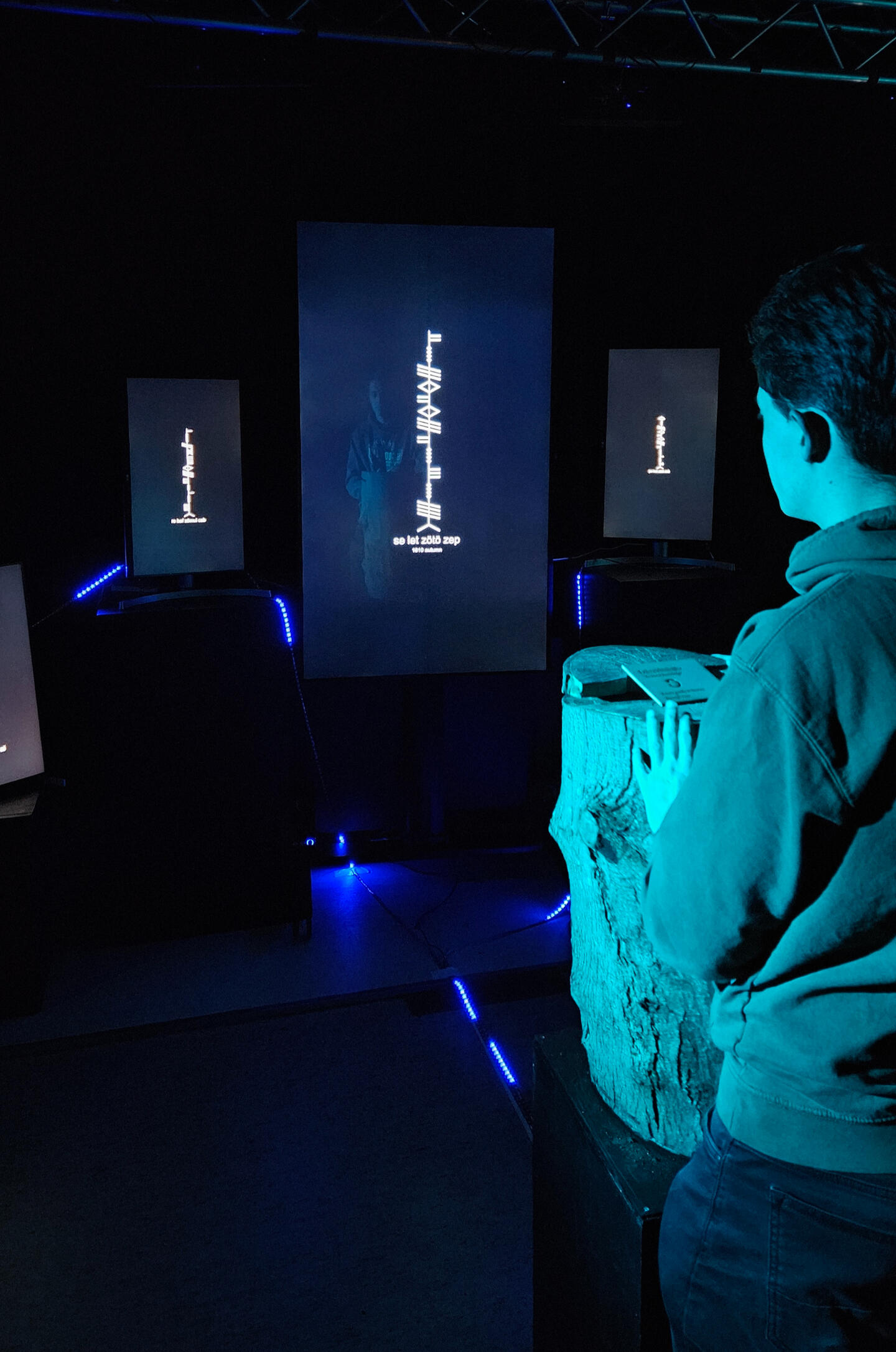
The language (Tamperséwan)
Tamperséwan, the language of trees, provides insights into human interference throughout the tree’s lifespan. Comprising numerous layers of storytelling and linguistic metaphysics, the installation invites users to enter a realm of curiosity and awe teaching or sparking the interest in the complexity of the life of a tree and the interference humankind had on its life. This sense of wonder ignites an interest in understanding the workings of this language system, prompting users to decide whether to delve into the cultural narrative of a tree’s life or simply interact with it and observe how the words evolve over time. Ultimately, the experience culminates in users becoming more engaged and immersed, deepening the sense of wonder with which they initially entered the installation.
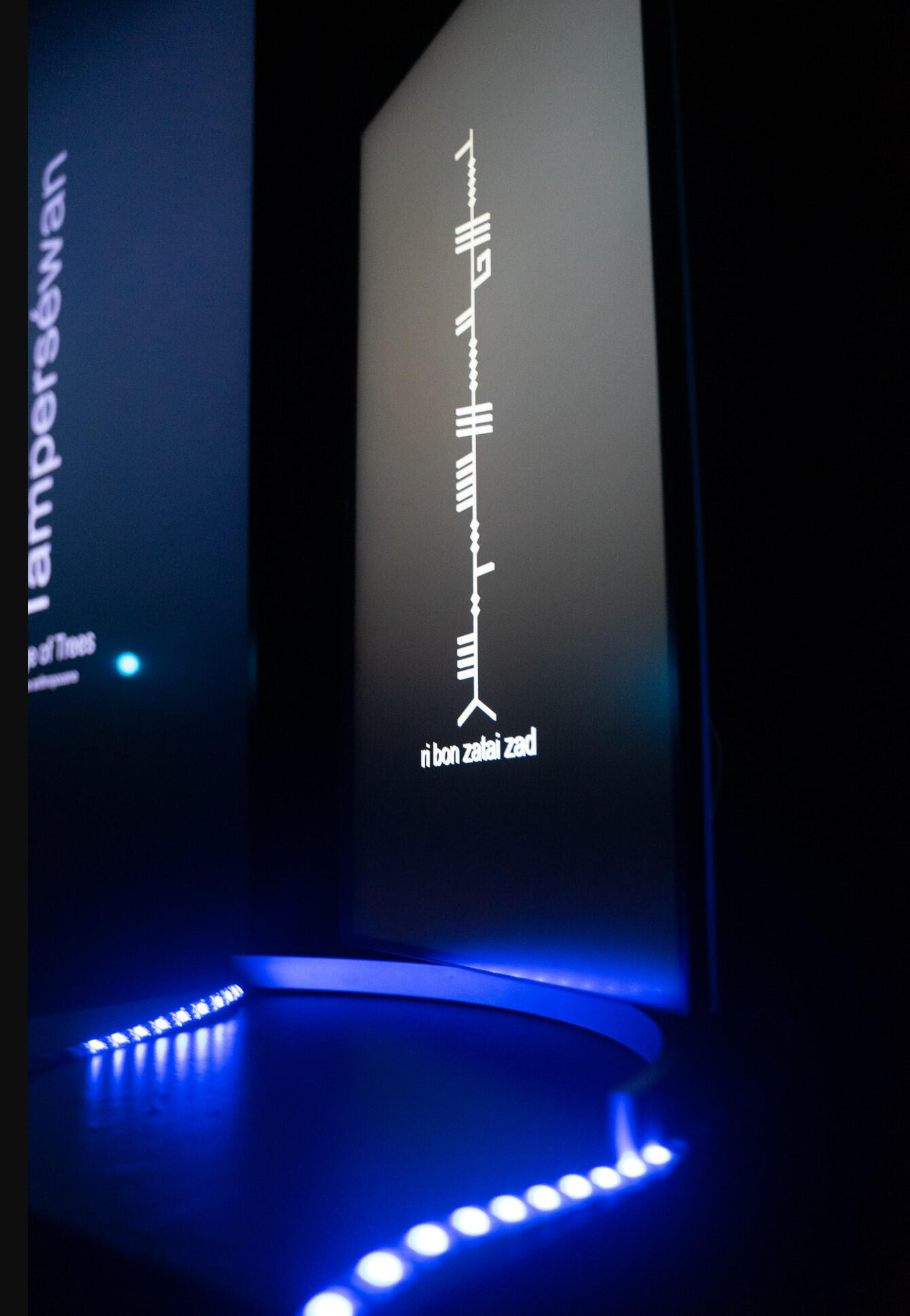
For the purpose of learning the language or to come closer to a better understanding, a fieldguide has been created. A documentation consisting of the principles that define this language. This guide explains the meaning of the various characters, their transliteration in Latin and their corresponding values derived from datasets.This fieldguide hangs to the side of the installation where one can walk past its pages step by step to go through the language letter by letter, syllable by syllable.
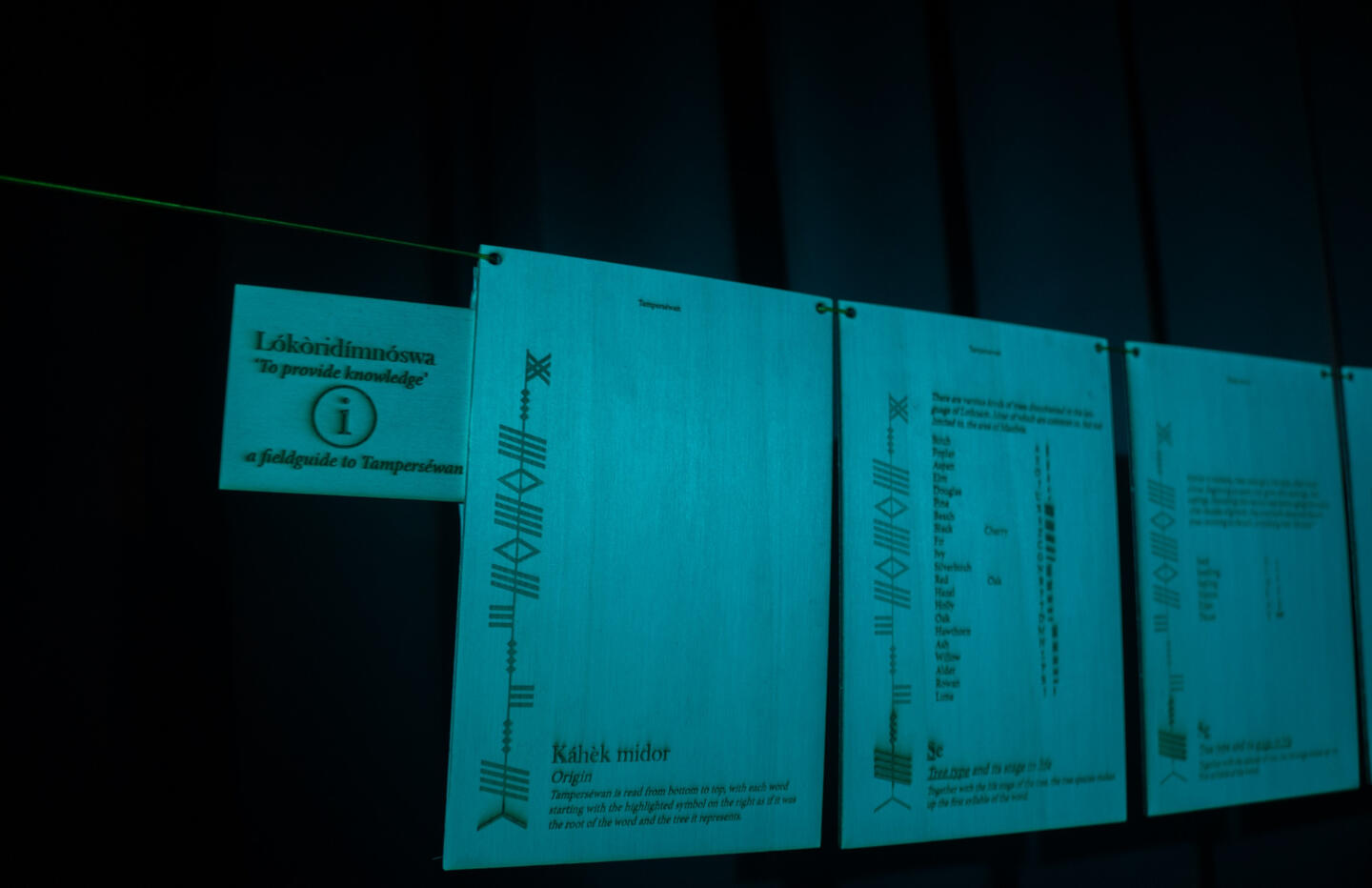
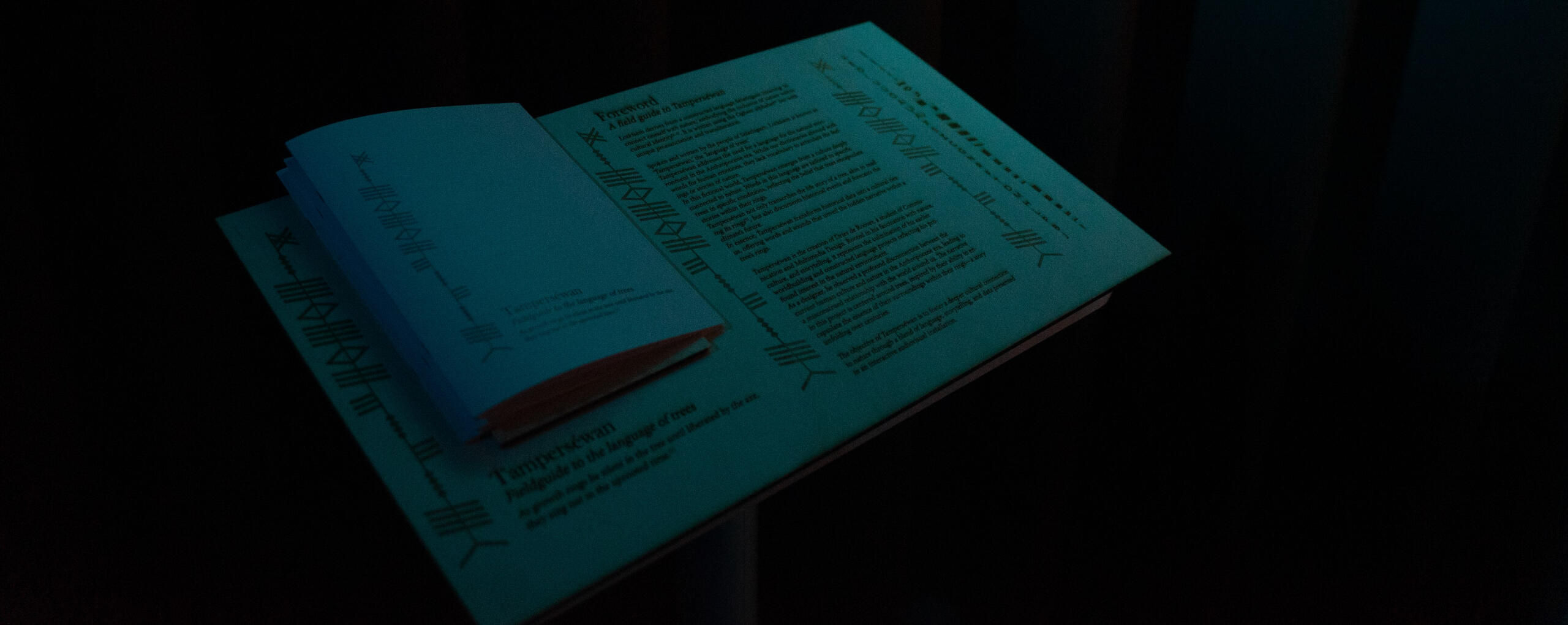
Sonification (Tampersèhram)
The language created for Lotkísèm has been transformed into nature-inspired sounds that act as the relaxing base layer, setting the tranquil ambiance of the installation. As visitors immerse themselves in the exhibit, they may imagine themselves seated on a bench, gazing in awe and wonder towards a beautiful landscape or park, their senses enveloped by the harmonious blend of language and nature-inspired melodies.Within the language, there exists a concept known as 'Tampersèhram', which translates to the voice of the tree. This term encapsulates the sonification process wherein the tree recounts the events of each season. When faced with adverse conditions that hinder its growth, the sonification adopts a somber tone. Over time, this melancholic resonance becomes more prevalent, reflecting the increasing impact of human interference on the environment and climate.
Given the extensive lifespan of trees, the ambient sound created through 'Tampersèhram' spans 2.5 hours, encapsulating the life journey of a beech tree over three centuries. As listeners immerse themselves in this auditory experience, they are transported through time, witnessing the tree's growth, struggles, and eventual demise.
Conclusion
As the catalyst for this project, Lotkísèm addresses the design question:How can a design inspired by language promote a cultural connection between humans and natural environment?By creating a language rooted in the experiences of the natural environment, particularly trees, Lotkísèm bridges the gap between human and environmental understanding. This culminates in Tamperséwan, a data-driven language presented through the life of a tree and an ancient, nature-inspired script (Ogham). Through layers of storytelling it stimulates the wonder and interest of its users, it ambiguously teaches its reader about the complexity of a tree's life and what kind of impact human interference had over time. To achieve this, project had an abstract approach to promote the engagement and interaction within the Lotkísèm installation in order to understand the words that are displayed.
Positioning
As a designer, I’ve observed a profound disconnection between the current human culture and nature in the Anthropocene era, leading to a misconstrued relationship with the world around us. In this project, I’ve centered the narrative around trees, inspired by their ability to encapsulate the essence of their surroundings within their rings—a story unfolding over centuries.Through my own fascination in storytelling, culture, worldbuilding, programming, music and nature I position myself as a designer to tackle this research question to create an interactive audiovisual installation that lets the user explore the culture inspired by trees and data.It is my personal interest that drove me to the subject of natureconnectedness. I have always felt drawn to nature and noticed myself losing track of time when I am in nature noting all of the interconnected things that make up a single tree or form the basis of a landscape such as a forest.Through this interest I became more aware of the disconnection other people, mostly urban dwellers, have with nature. The lack of nature in their own environment, be it at home, work or on the streets, causes them to deform their relationship with nature. This is why I chose to challenge myself to use the skills I have learned throughout the years to make people aware of this (cultural) misunderstanding of us perceiving and reading the natural environment.
Showcase
References
[1] W. W. Gaver, J. Beaver, and S. Benford, “Ambiguity as a resource for design,” Proceedings of the conference on Human factors in computing systems - CHI ’03, 2003, doi: https://doi.org/10.1145/642611.642653.[2] Paleis het loo, ‘’Silent Witness’’. 2023.[3] J. N, “What is nature connection?,” Nature To Go, Oct. 16, 2022. https://www.naturetogo.ie/post/nature-connection (accessed Jan. 25, 2024).[4] M. Richardson, Reconnection. Pelagic Publishing Ltd, 2023.[5] Wikipedia Contributors, “Ogham,” Wikipedia, Mar. 16, 2019. https://en.wikipedia.org/wiki/Ogham[6] “Data from Tree Rings to Determine Historic Weather Patterns,” Climate Data Information. http://www.climatedata.info/proxies/tree-rings/index.html (accessed Jan. 25, 2024).[7] J. Stoller-Conrad, “Tree rings provide snapshots of Earth’s past climate,” Climate Change: Vital Signs of the Planet. https://climate.nasa.gov/news/2540/tree-rings-provide-snapshots-of-earths-past-climate/#:~:text=The%20light%2Dcolored%20rings%20represent
